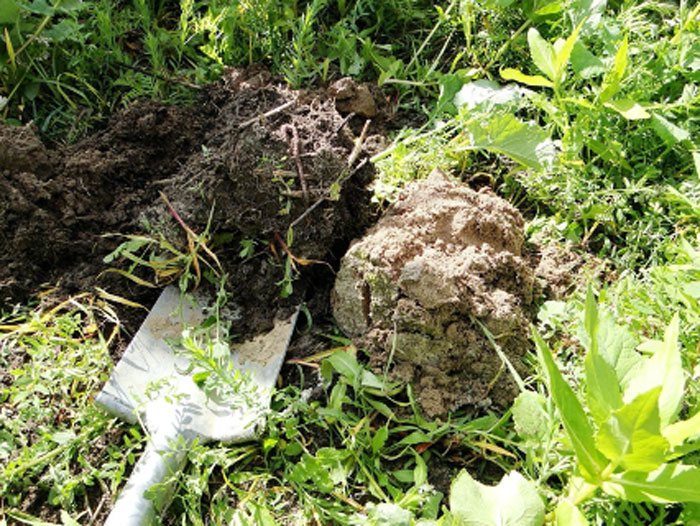Building soil health is a long-term endeavor, but one with lasting impacts. There are many practices that yield great short-term benefits. But if it’s not good for the soil, it won’t be good for the farming enterprise in the long run.
I have three basic rules for protecting and building soil health.
- Ensure soils are constantly covered and fed.
- Avoid compaction completely — keep machinery weight below 4 tons per wheel.
- Adjust crop rotations to feed the soil and build fertility.
Get Digging
Evaluating soils — not having them evaluated — is essential to identify problems, guide practices and measure progress.
Don’t ever let anyone else dig your soils. I hear all the time from farmers that they’re not agronomists or soil scientists, so what would they know? I tell them, “Just dig, and you’re going to find stuff very interesting.”
When I dig, I use all my senses. The size, location and number of roots, the color of the soil, if the soil is hard and compacted or if it crumbles at the touch or how the soil smells can be very telling. More telling than soil testing. Two soil cores may produce the same analysis from a soil test, however visual assessment will show they’re far from the same.

SAME NOT EQUAL. Soil tests say these two soils are the same, however a visual assessment shows they’re likely to perform very different from one another, says Odette Ménard.
I’ve seen soil cores taken just a few feet apart. One was dark, aggregated, full of roots and hosted an earthworm. The other was light in color with no visible life and roots only in the top couple inches. The healthier soil had a water infiltration rate of 1 meter per day while the other could only absorb 0.05 meters of water per day — a huge difference for two soils that traditional testing would say are essentially the same.
One soil allows for extensive root systems, the other for very shallow, limited root systems. Extensive roots are efficient roots. Nitrogen (N) use efficiency ranges from 28-60% in corn. More robust roots allow more N to go toward growing grain.
Naked Truth
Soils perform best when they are well covered and have living roots to act as a 24-hour buffet to soil microorganisms.
Roots are the base of the food web. They produce exudates that feed microorganisms which in turn produce glomalin — soil structure supporting glue. The resulting structure increases soil porosity.
“We can’t change soil texture, but we can change the biology and physics of soil…”
We can’t change soil texture, but we can change the biology and physics of soil. Increasing soil porosity improves soil aeration and water infiltration. The less dense a soil is, the more roots can penetrate it and the more tonnage of plant matter can build soil organic matter (SOM) which, in turn, allows soils to hold more water.
Soil filled with air, water, and roots creates habitat for soil organisms, which feed on SOM to produce fertility for plants and so the circles go.
Ground Level
Roots supply water and nutrients, improve soil structure, and sequester carbon. Whereas only 8% of surface plant growth will become SOM, 45% of root carbon becomes SOM.
Living roots of varying types should be constantly present and should be left to grow for as long as possible. Longer-lived roots provide more soil-securing glue. Soil bound in aggregates allows water to move through the profile without also moving soil particles. When soil particles move, they settle in deeper soil pores, increasing soil density and blocking further water movement.
While roots can glue things together, they’re not nearly as good at jackhammering soil apart as many believe. A root has to have a path to grow. It can’t break through concrete but it can get in a crack and make it bigger.
In the top 24 inches of the soil profile, 44% of roots share a path with at least three other roots. Beyond 24 inches, 85-100% of the roots will be fine enough to travel through the soil alone if there’s a crack to follow.
Weight also moves through the soil. Farmers must carefully manage tire type, air pressure and weight. Air pressure impacts the first 0-8 inches of the soil profile. Air pressure and weight can create compaction in the 8-20-inch zone of the soil profile.
We need to use the whole soil profile to maximize yield. The rule is 0-15 psi to avoid surface compaction and no more than 4 tons of weight per wheel to avoid subsoil compaction.
The drivers of soil health overlap repeatedly. Soil structure and soil organic matter work together to ensure water and oxygen is available to plants. Soil structure and biological activity combine to create habitat. Biological activity and organic matter together take care of fertility, or the ability of the soil to feed plants. Where they all meet, we get soil health and truly sustainable agriculture.






